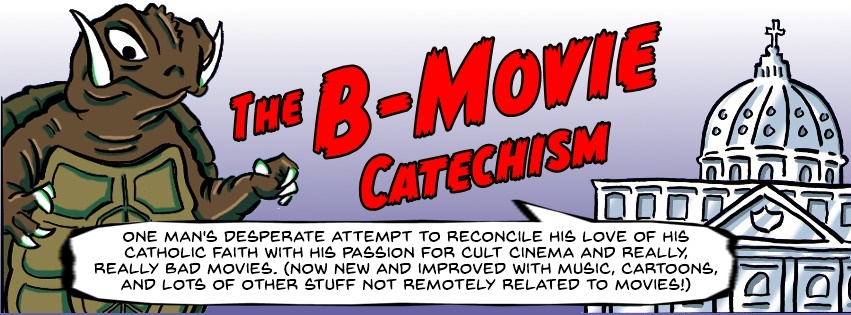TYPICAL REVIEW
"OK, it's cheesy, it's stupid, it's cheap, it’s nearly inept, but, by golly, it's a hoot to watch." - Bob Bloom, JOURNAL AND COURIER (LAFAYETTE, IN)
THE PLOT
It’s the end of the world as we know it. Ro-Man XJ2, invader from space, has eliminated almost everyone on Earth with his Calcinator Death Rays. A small band of people have managed to survive but Ro-Man is still on the prowl and there's dangerous stock footage of giant man-eating lizards to contend with. Will humanity survive or will Ro-Men rule the Earth?
THE POINT
Anybody out there with a good friend who is also a film-major knows they will eventually get the call to appear in one or more school projects. And because it is still school, the productions can sometimes veer towards the noncommercial and bizarre. I have fond memories of the time I was asked to wear a gigantic squirrel costume lovingly hand sewn by the director's mother. They did their best to make the rig comfortable, but the mystery fur it was made from was blazing hot inside; the four foot long, two foot wide tail that hung precariously from my wire shoulder harness was unwieldy and heavy; and the fur covered paper-mache head had zero visibility and refused to turn when I did. In short, I looked ridiculous.
I only mention that experience because, even with the $5 budget my friend had for costuming, I still looked more believable than Ro-Man. Even if you’ve never seen Robot Monster, you’ve probably seen an image of Ro-Man. He’s become the poster child of cheapo 1950’s sci-fi. That’s him in the picture up above. Yes, that is indeed a gorilla costume topped by a diving helmet with TV antennas glued to it; pure B-Movie goodness.
Ro-Men, giant grasshoppers, astro-zombies, nuclear mutants; you name it; back in the 50’s they were going to kill us, all of us. Just because they lack the budget of Titanic or Armageddon, these types of “end of the world” films can still be considered part of the larger genre known as “disaster movies” and they’ve been around since the beginning of cinema. Thanks in large part to the Cold War, they really began to be produced in large numbers in the years following World War II. After fading a little in the 60’s, they came back strong after the Vietnam War and have stuck around ever since. These days you can count on at least two or three good old fashioned “end of the world” movies every year.
It's important to note the timing of these apocalypse flicks. Although you would expect the exact opposite, Hollywood tends to churn out a higher number of disaster movies during times of national stress or emergency. And Hollywood wouldn’t do it if people weren’t willing to shell out some money to see it. The best guess I’ve heard as to why this is so is that these movies are not just about facing disaster, but surviving it. As one critic points out, “Old people and pregnant women are rescued, children are lifted from the rubble, and love affairs blossom.” The aliens of Independence Day’ may blow up the White House and Ro-Man may blow soap bubbles (Watch the movie, I’m not kidding), but the movies themselves end up offering a positive message.
Take the United States Council of Catholic Bishop’s review of the “end of the world” spectacular “The Day After Tomorrow” for example. It states that “Sadly, in a film dealing with tragedy on a worldwide scale, references to God or spirituality are noticeably absent, apart from a few scattered verbal afterthoughts. However, buried beneath the blockbuster budget and apocalyptic visuals is a message about familial love, selfless heroism and the indomitable spirit of man.” In short, through perseverance, belief and the right moral choices, the human race has the ability to be saved.
Sadly, for the last remaining humans in Robot Monster, they're not up to the task. They're so crippled by their own bickering, indecisiveness, condescension, and selfish desires, that they never really stand a chance. By the end of the movie, only one small boy is left to watch as Ro-Man destroys the Earth with soap bubbles and sparklers. Bummer.
THE STINGER
Natural Evil is the term theologians apply to the suffering caused by things like natural disasters or disease; things not typically related to human choice. Which leads to the inevitable question of why would a loving God create a world in which there is Natural Evil in the first place? One train of theological thought is, if there were no possibility of natural disasters or diseases, if we existed in some kind of Wonderland in which everything we needed or wanted was taken care of without any risk or effort on our part, it might not really be the best thing for us. Realistically, if we lived in that kind of utopia, would we ever worry about anything other than our own immediate pleasure? With human beings being the self-serving creatures they are, maybe it’s just not possible to create a world in which no suffering exists and still have people choose the things that make them grow spiritually. It would appear that, by giving his creations free will, God has voluntarily limited His own omnipotence. Sure, He could easily step in and end all suffering on Earth, but the cost would be our freedom of choice. And without choice, how could we grow into the people God wants us to be?


1 comment:
Good reflection on evil. Three thumbs up!
Histor the Wise Mutant
Post a Comment